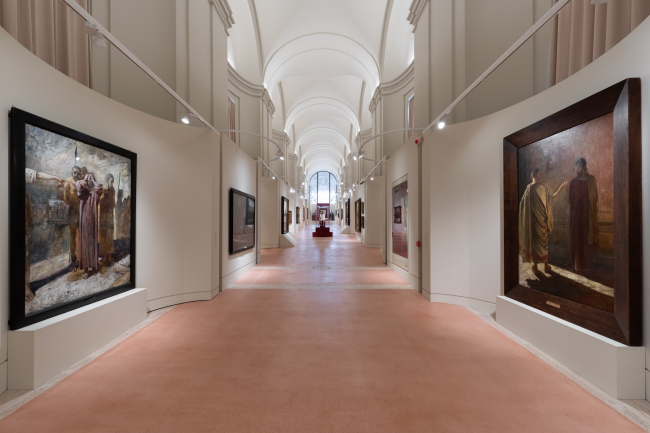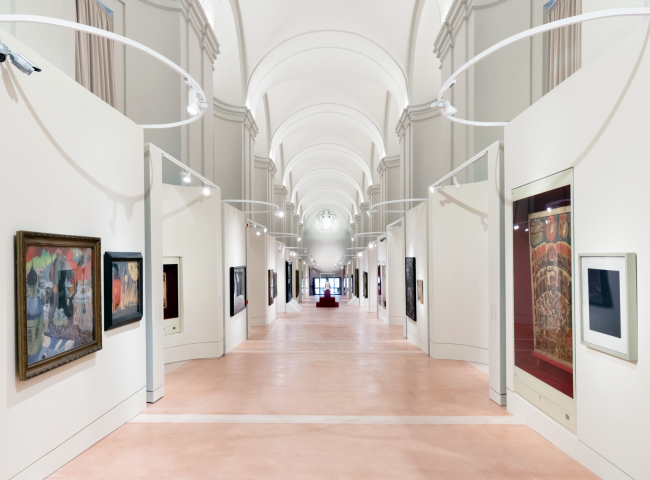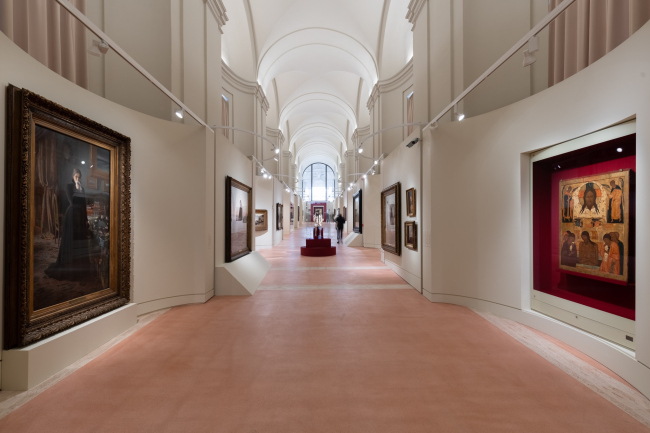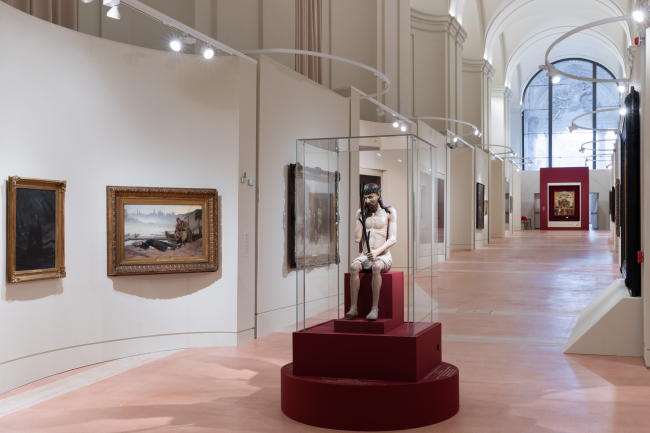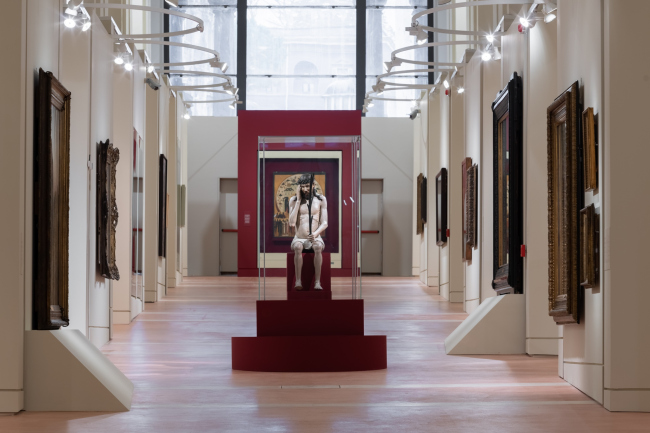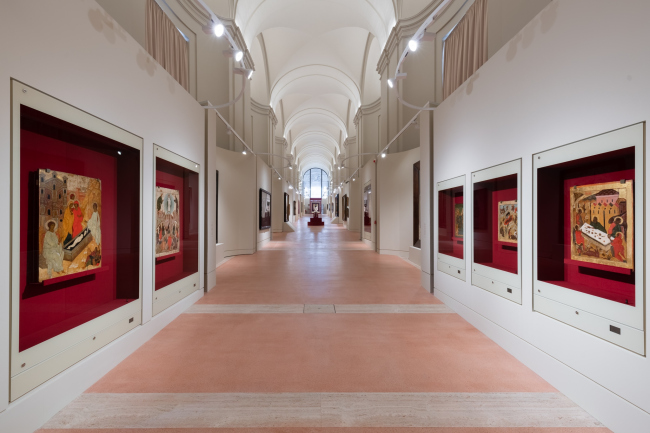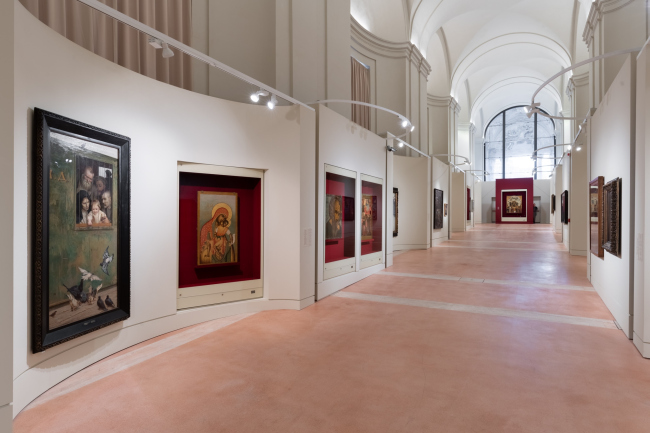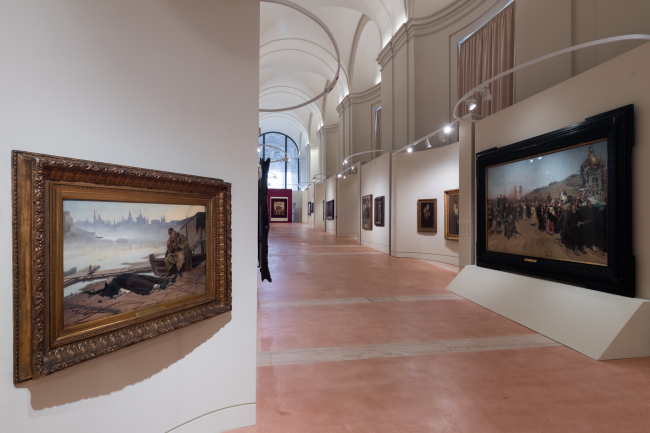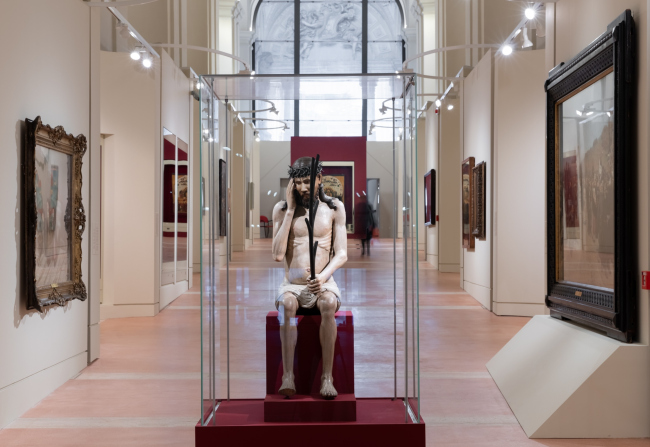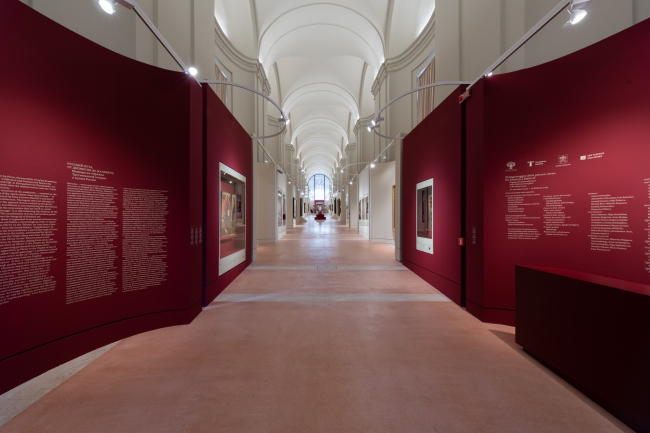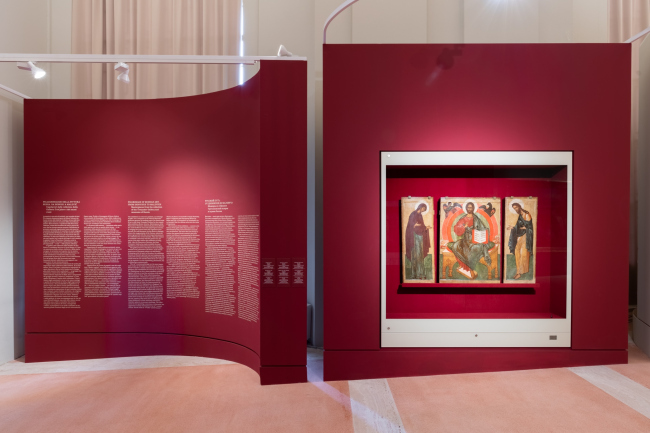|
Published on Archi.ru (https://archi.ru) |
|
| 26.11.2018 | |
|
Icon vs Painting |
|
|
Julia Tarabarina |
|
| Studio: | |
| Planet9 | |
|
The curator of the exhibition “Pilgrimage of Russian Art. From Dionysius to Malevich”, Arkadiy Ippolitov, mixed up works from different centuries, while the design of the exposition, developed by Sergey Tchoban and Agnia Sterligova, helps to arrange these intertwined sophisticated narratives, joining them together with a glow of holiness. “Pilgrimage of Russian Art. From Dionysius to Malevich”. Vatican, Rome. Exposition design: Sergey Tchoban, Anna Sterligova (Planet 9). Photograph © Vasiliy BulanovAs is known, the colonnade of the St. Peter’s Square looks like a pair of arms that embraces it. However, although over the centuries many people have passed underneath the powerful Tuscany columns designed by Giovanni Lorenzo Bernini, fewer paid attention to the “wrists of the arms”, the closed galleries running from the oval of the colonnade towards the cathedral- mostly because of the fact that until recently they both were closed to visitors. It was only in front of the Constantine wing (named so after the equestrian statue of the emperor), which is situated to the right of the person entering the cathedral, that one could peek over the shoulder of the Swiss guard to see the baroque hyper-perspective of Scala Regia. The Constantine wing is still closed to visitors, but the opposite “wrist” of the colonnade, which is situated on the right of the cathedral and on the left of the flow of the tourists and pilgrims, the Charles the Great wing, was recently handed over to the Vatican Museums by the Holy See, and now this place hosts various exhibitions. It is here that the “response” exhibition by the Tretyakov Gallery to Vatican’s Roma Aeterna, which was held in Moscow two years ago, is hosted; back then, the State Tretyakov Gallery exhibited masterpieces from the Vatican Museum, and the time has come for the second stage of cultural exchange – 47 pieces from Tretyakov Gallery have come to Rome, plus seven more came from other Russian museums. Arkadiy Ippolitov has become the curator of both exhibitions (2016 in Moscow and 2018 in Rome), the design of the expositions being developed by Sergey Tchoban and Agnia Sterligova. We will note that the exhibition in the State Tretyakov Gallery was designed as a semblance of the colonnade of St. Peter’s Basilica, while the response exposition of the Russian art is in fact hosted in it. An exhibition of masterpieces is a special genre, whose laws have long since been carved in stone, one of which is the mandatory chronological sequence, which makes any such exhibition, especially if it covers a span of 400-500 years, predictably similar to a museum exposition, and relentlessly classical: XVI, XVII, XVIII century and so on, Russian art is shown from ancient icons to avant-garde through the Peredvizhniks (painters of the XIX-century Russian realist school). With an intention to break away from this cliché, Arkadiy Ippolitov mixed up the whole chronology, building up conceptual and – in a broad sense of this word – iconographic parallels between the works of different ages. To some people, the result looked still rather predictable because the talks about the spirituality of the Russian avant-garde art have been going on for quite a long time, and there is nothing exactly groundbreaking about them. To some people, however, the result looked pretty provocative because it is one thing to put “What is Truth?” depicting Christ and Pilate or “Golgotha” by Nikolay Ge or “Prayer of the Cup” depicting Christ In Gethsemane by Vasiliy Perov alongside the evangelic cycle of iconostases, or the wooden “Christ in the Dark Cell” effigy alongside “Christ in the Desert” by Ivan Kramskoy, and it is quite a different thing finding the features of a Christian martyr in the member of “Narodnaya Volya” revolutionary movement in “They Did Not Expect Him” by Ilya Repin or comparing “Mother Do Not Weep For Me” orthodox icon to “Inconsolable Grief” by Ivan Kramskoy, or putting “The Demon Seated” by Mikhail Vrubel in the context of Orthodox painting, or cross-referencing Malevich’s Black Square to the Judgement Day (one must say that in this specific place the Black Square looks humble and modest, nothing like a provocation but as a full stop of sorts). One can also see here quite unexpected cross references, for example, comparing the curves of the red communist banner in “The Bolshevik” by Boris Kustodiev with the Snake the Instigator. “Pilgrimage of Russian Art. From Dionysius to Malevich”. Vatican, Rome. Exposition design: Sergey Tchoban, Anna Sterligova (Planet 9). Photograph © Vasiliy Bulanov“Pilgrimage of Russian Art. From Dionysius to Malevich”. Vatican, Rome. Exposition design: Sergey Tchoban, Anna Sterligova (Planet 9). Photograph © Vasiliy Bulanov“Pilgrimage of Russian Art. From Dionysius to Malevich”. Vatican, Rome. Exposition design: Sergey Tchoban, Anna Sterligova (Planet 9). Photograph © Vasiliy Bulanov“Pilgrimage of Russian Art. From Dionysius to Malevich”. Vatican, Rome. Exposition design: Sergey Tchoban, Anna Sterligova (Planet 9). Photograph © Vasiliy BulanovOne way or another, in spite of the all the obviousness of the idea, this is the first time that it was shown so loud and clear. On the other hand, the exhibition is definitely all about the manifestation of the Christian foundation of even the militantly atheistic, God-seeking, revolutionary and Bolshevik paintings – which is ultimately quite appropriate here in Vatican. But then again, there is a downside to it – the credo, the “I believe” of the Russian art starts sounding slightly grotesque here, as if it is taking the oral exam to become a member of the All-Union Leninist Young Communist League. Generally speaking, the Russian press reacted to the exhibition more in terms of the greatness of Russian art in general, while the western media mentioned Vatican’s policies and the fact that Pope Francis has a soft spot for “friendship through art”, and this is where yet another contradiction of modern life comes up: we sometimes suddenly remember a schism and start preparing a new one, or we sometimes are almost preparing for the Council of Florence or the Third Vatican. In actuality, this is not the case, of course: it’s just that different layers of the pluralist atmosphere of this day and age can play home to many different cultural trends – but we will also note that the concept proposed by Arkadiy Ippolitov created lots of meaningful tensions, which hold the exhibition together and make it almost resonant – its contents are full of inner energy. The space of Giovanni Lorenzo Bernini is also far from neutral. It is, of course, more sedate than Scala Regia, where the steepness of the slope that one has to conquer is emotionally enhanced manifold; but here the floor is also sloping, it rises from the square up to the cathedral, provoking, however slight, effort from the walker; as for the walls, they consist of flattened baroque exedras – the long array of waves looks like the capellas of a catholic temple, and at the same time one could easily envisage them to be the walls’ reaction to the conceptual tensions that arose at the exhibition. Thus, Sergey Tchoban and Agnia Sterligova got in the crossfire of the narrative of the exhibition and the emotional Bernini space – and they chose for the exposition design a maximally sedate solution, subjugating it to the interior. The expo modules about three meters high follow the contours of the walls and repeat, one tone lighter, their beige-gray color: they go deeper into the recessions of the exedras, make little walls before the pylons, and generally form a “second skin”. The gallery is not really wide, and blocking it halfway would be a wrong thing to do – what remains inside is only “Christ in the Dark Cell”, the only sculpture at this exhibition, which forms a cross aisle with the two neighboring exedras. “Pilgrimage of Russian Art. From Dionysius to Malevich”. Vatican, Rome. Exposition design: Sergey Tchoban, Anna Sterligova (Planet 9). Photograph © Vasiliy Bulanov“Pilgrimage of Russian Art. From Dionysius to Malevich”. Vatican, Rome. Exposition design: Sergey Tchoban, Anna Sterligova (Planet 9). Photograph © Vasiliy BulanovEverything else is grouped along the walls but in such a way as to sort out what the curator mixed up in an all but imperceptible yet a logic and clear way. The pictures of the XIX and XX centuries are hanged on the light surfaces of the exhibition modules; the icons, on the other hand, are sunk into the recessions, icon cases of sorts, which open up the imaginary matter of the walls: the color of Eucharistic wine or the Most Holy Mother of God. And it turns out that the light-colored surface of the expo modules is in fact the verge between the deeply spiritual art of the Middle Ages and the explorations of the same Christian issues in the early modern period. Or the line between the reverse perspective of the divine, uncreated space – and the realistic construction of the illusory man made world. In other words, the exposition structures include two layers: for the iconographic church art and the pictures of the early modern period – which makes it possible to highlight how essentially the same topics “show through” in different epochs – and uncover the curator’s original idea, at the same time avoiding an utter and chaotic mix-up by subtly, almost on the level of the viewer’s instincts, sorting out the two components of the exhibition. If we are to go one step further, we can imagine that this whole neutrally white surface devours yet another problem of Russian art – the absence of the Renaissance period in it, which was all about the formative years of the problems of the style of the early modern period. “Pilgrimage of Russian Art. From Dionysius to Malevich”. Vatican, Rome. Exposition design: Sergey Tchoban, Anna Sterligova (Planet 9). Photograph © Vasiliy Bulanov“Pilgrimage of Russian Art. From Dionysius to Malevich”. Vatican, Rome. Exposition design: Sergey Tchoban, Anna Sterligova (Planet 9). Photograph © Vasiliy Bulanov“Pilgrimage of Russian Art. From Dionysius to Malevich”. Vatican, Rome. Exposition design: Sergey Tchoban, Anna Sterligova (Planet 9). Photograph © Vasiliy Bulanov“Pilgrimage of Russian Art. From Dionysius to Malevich”. Vatican, Rome. Exposition design: Sergey Tchoban, Anna Sterligova (Planet 9). Photograph © Vasiliy Bulanov+ But then again, according to the authors, the wine-red color has yet another connotation: it connects the Roman exhibition with Moscow’s two-years-ago Roma Aeterna – that one was completely wine-red, although with a twist of a brownish copper hue. In this case, however, the purple, not being restricted to the space of the recessions, appears in the space of the exhibition three times: at the entrance and at the side end of the gallery, marking the beginning and end of the visitor’s progress, as well as in the pedestal of “Christ in the Dark Cell”, thus marking the center of the exhibition. At the same time, the purple walls accentuate the inherent beginning of Russian art and complete it with a powerful chord – Glory of Our Lady on the throne. “Pilgrimage of Russian Art. From Dionysius to Malevich”. Vatican, Rome. Exposition design: Sergey Tchoban, Anna Sterligova (Planet 9). Photograph © Vasiliy Bulanov“Pilgrimage of Russian Art. From Dionysius to Malevich”. Vatican, Rome. Exposition design: Sergey Tchoban, Anna Sterligova (Planet 9). Photograph © Vasiliy BulanovThe visitor’s progress deserves a special mention. Although the Russian name of the exhibition literally translates as “The Russian way”, the international version of the name is “Pilgrimage of Russian Art” or “pellegrinaggio” or “pèlerinage” in Italian and French respectively. In interviews and various statements, a third name of “Calvary” appears – apparently, the term “Way of the Cross” was left as a parenthesis or cut away from the original name in order to soften the fanfare and give the project a greater freedom of interpretation. The architecture of the Bernini wing with its eastward ascent fits in perfectly with the idea of a pilgrimage, a way of the cross, and even makes one remember the numerous stairways leading up to the castles of the Catholic Europe, meant to become the scene of the “Cross Bearing” ceremony – let’s remember, for example, the stairway to Notre Dame de la Garde in Marseille, the stairway to Trinità dei Monti in Rome, or the ascent to San Miniato al Monte in Florence. Here, in the case of the Charles wing, the ascent is not that great, although still perceptible, and the visitors or pilgrims go not to Saint Peters (although indeed it this direction) but move inside the space of the problems of Russian art, interpreted here as acutely Christian. One must hardly mention the fact that today an icon for Catholic temples is a welcome and interest-evoking image for praying, some carrier of mystery, as opposed to the habitual and traditional sculptures and altar images. The arcs of white planks that bear the lights, follow the curves of the exedras with a one iteration shift – and serve not to separate but to unite all the exhibited materials. Hovering a meter above the visitors’ heads, their white graphics look like the Early Renaissance halos, which are inscribed in the perspective of the pictures. They look as if they were making up for the absence of Renaissance, and, at the same time, are not only highlighting but also throwing a divine light upon the whole exhibition, accentuating the holiness of its subject matter and even uniting them. It is amazing how, by using such modest and simple means, the author was able to both separate and at the same time unite such a great amount of valuable and diverse material. |
|
